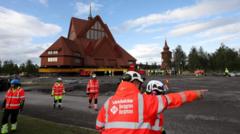Mumbai's architectural landscape has been shaped significantly by the Art Deco movement, which emerged prominently at the 1925 Paris exhibition. This year marks a century since its introduction, and the city stands as a vibrant testament to this style, boasting the largest documented collection of Art Deco buildings globally.
Art Deco, characterized by geometric patterns, sweeping curves, and bright motifs, reflects a departure from the ornate styles of previous eras, symbolizing optimism in a rapidly modernizing world. This style found its way into various structures in Mumbai, from cinemas and schools to private residences, integrating local design elements that echo the city's colonial past.
Architect Atul Kumar, founder of the Art Deco Mumbai Trust, emphasizes the cultural significance of these buildings, stating that while their architectural beauty is evident, many residents remain unaware of the heritage entwined with their homes. The influence of Art Deco has seamlessly mingled with Mumbai's identity, embedding itself in public consciousness.
However, as Mumbai undergoes rapid urban development, these historical structures face threats from modern construction practices favoring utilitarian designs. While some buildings have been lost, efforts to document and preserve the remaining Art Deco architecture are gaining momentum. Community initiatives are underway, providing support for property owners to maintain and restore these iconic buildings.
In addition to preservation efforts, contemporary designers like Nidhi Tekwani are re-imagining Art Deco aesthetics, aiming to adapt classic designs into modern furnishings suitable for today's living spaces. This evolution signifies an ongoing appreciation for Art Deco while addressing the needs of contemporary society.
As Mumbai celebrates this architectural milestone, it reflects on a hundred years of cultural evolution and resilience, demonstrating the enduring appeal and significance of Art Deco in shaping its urban narrative.
"





















